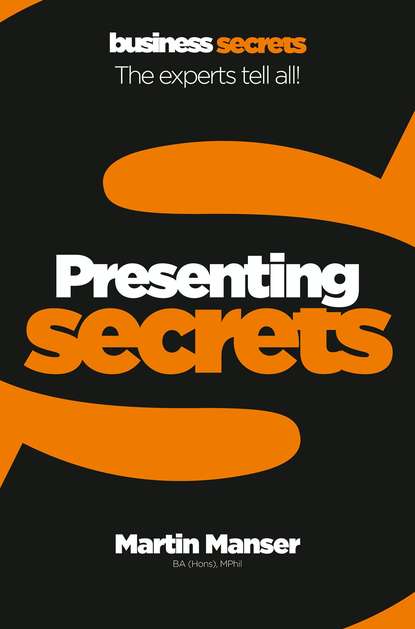По всем вопросам обращайтесь на: info@litportal.ru
(©) 2003-2025.
✖
Presenting
Автор
Год написания книги
2019
Настройки чтения
Размер шрифта
Высота строк
Поля
• Care for others. Don’t become so absorbed with yourself that you neglect people around you, in your community and in the wider world. Take a stand on world issues, and engage in some practical action.
• Stretch yourself. What areas of life that are currently weak do you want to develop? Sketch them out and then begin to work on the next steps to fufil them.
• Don’t take yourself too seriously. Watch TV. Relax – and laugh at yourself.
• Cultivate your spiritual/emotional side. Whether it’s religion or poetry. We’re not just thinking machines.
• Work on the physical side of your life. Take control of your life. If you’re out of condition, go to the gym regularly: if you want to lose weight, join a slimming class.
Cultivate a positive attitude about yourself as a great presenter.
1.2 Know your aims (#ulink_5e4aa09e-14cc-5a75-b645-30add687cbbf)
It’s vital to know why you are giving your presentation. It is important that you define the purpose of what you are presenting in one sentence. This will clarify what you should include – and what you can safely leave out. Having a concise, clearly expressed aim in front of you in all your preparation will help guide your thoughts.
Think why you have been asked to give a presentation. It may even be that a presentation is not the only way (and possibly not even the best way) of communicating a message.
See your presentation as one part of an aspect of the communications of your company or organization. Other ways of giving a message include email, the company intranet, a memo or report, posters, group discussion, one-to-one meetings, managers and bosses
one minute wonder In preparing a presentation, it can be very helpful to think of one typical person in the audience. Will he or she understand what you are saying and be persuaded by its message? Imagine you are talking to a personal friend.
“If you don’t know where you are going, you will probably end up somewhere else”
Dr Laurence J. Peter and Raymond Hull, authors of The Peter Principle
who model certain behaviour to build trust. Ask the following questions about your presentation:
• Who is in the audience? What are they like? What do they already know about the subject? You can then make sure that what you are saying is suitable for their level.
• What are the main messages? Are you clear about the essential information and ideas you want to communicate?
• What do you want to achieve? This is what you want people to do or think, understand or accept as a result of your presentation. Do you want colleagues to accept future sales forecasts? Or be persuaded to adopt a new product? How will you measure people’s reactions to know whether you have fulfilled your aim?
• How are you going to make your presentation? For example, how formal is it? Will you stand or sit? What visual aids will you use?
• How long will you speak for? Will there be time for questions? What is the room like? How will the audience be seated?
• What’s the big picture? Where does your presentation fit into the overall picture of communications in your organization?
Work out exactly what you want to achieve with your presentation.
1.3 Know your audience (#ulink_5010d5b2-91ad-55e7-aa08-e3d3a84f7c9a)
It’s important that the focus of your presentation is your audience. You should do all you can to research your audience so that you can pitch at the right level. Here are eight things to think about.
1 How many people will be at your presentation? The way you give your presentation will vary greatly if the audience is five people, 20, or 200.
2 What does the audience already know about the subject? If you don’t know, ask the organizer. Knowing this will enable you to decide whether to go over the basics and how much you will need to explain jargon.
case study Adam’s failure was when he presented the keynote speech at a major conference. He knew that the company had paid a lot to secure the keynote slot, and he therefore assumed incorrectly that he had to do a hard sell. In reality, the audience was a group of distinguished analysts, and they were interested in industry trends. They reported later that the company still didn’t understand the enterprise. What Adam should have done was simply inform them of the trends the company sees, and that would have built credibility and even positioned the company as market leader.
3 What are the attitudes or feelings of the audience likely to be towards the subject you are presenting – and to you?
4 What expectations does the audience have of you as the presenter?
5 Do members of the audience know one another? Do they have good relationships with one another?
6 Will members of the audience be present because they have to come to your presentation or because they want to be there?
7 Are there any hidden agendas or underlying tensions that you should be aware of?
8 Who are the decision makers in the audience? What are their opinions?
Find out as much as possible about your audience in advance.
1.4 Consider how people learn (#ulink_f4cf75de-1e9f-5059-b45e-7c9d0e9942c8)
People learn in different ways. If you want to communicate effectively, you will vary the ways in which you present information. As a presenter, you should put yourself in the place of members of your audience. If you want to be sure of success, you should remember that people learn in different ways.
There are three main kinds of learning style:
1 Visual learners. Such people like to see information in pictures, diagrams, charts, tables and in writing.
case study Peter led a workshop on communication at which his wife was present. She pointed out to him during a coffee break that some members of the audience were losing interest and motivation. “Get them involved,” she advised. Peter followed her advice and adjusted his method for the next section from presentation to role play: he divided the audience into three small groups which each took different parts. The result: a more highly-motivated audience and more effective learning.
2 Auditory learners. Such people like to listen to information and then discuss it with others, listening to what others say, to help them learn.
3 Kinaesthetic learners. Such people like to be active and learn by doing.
In your preparation as presenter, you should be aware that people learn in different ways. Good presenters will use a multi-sensory approach to include different styles of learning so that every member of the audience will be able to take in the presentation effectively. This means that you should provide visual aids that illustrate and give headings to support your argument, provide opportunities for discussion and make room for expression through stories and role play.
In your preparation, explore different ways to make your presentation more effective.
1.5 Think creatively (#ulink_5b7824ac-ecae-5b4b-abb3-e45721cf529d)
Once you are clear about the aims of your presentation in your own mind, you are ready to move on to the next stage, which is to think creatively. Time spent thinking is not wasted: it will mean that your final presentation is clearly structured and easy to follow.
The best way to think creatively is to write about your thoughts in a pattern diagram sometimes called pattern notes, or Mind Map™. This is a creative diagram you draw that captures all the main aspects of your central thoughts as you see them. To do this, you should:
• Take a blank sheet of A4 paper, arranging it in landscape format.
• Write the central thought or theme (a word or a few words, not a whole sentence) of your presentation in the middle of the paper.
• Write around that central word other keywords that relate to it.
• Keep branching out, adding other points that come into your mind.
one minute wonder Acronyms can be a creative way of organizing thoughts and messages. Consider this TOWER acronym for the task ahead: T: thinking O: organizing your thoughts W: writing a first draft E: editing and R: revising the grammar.












